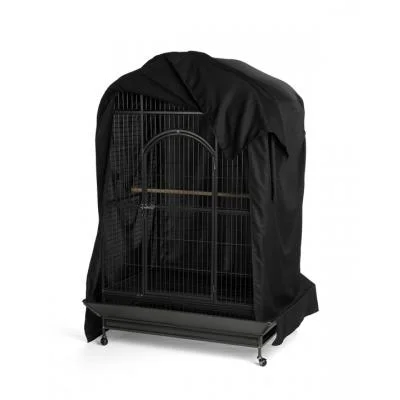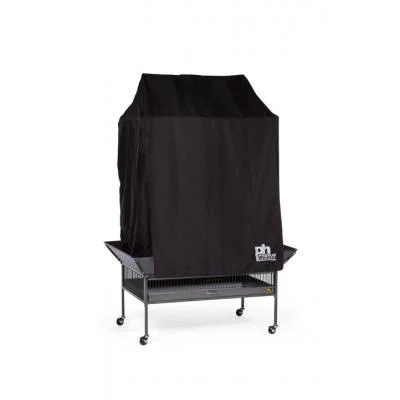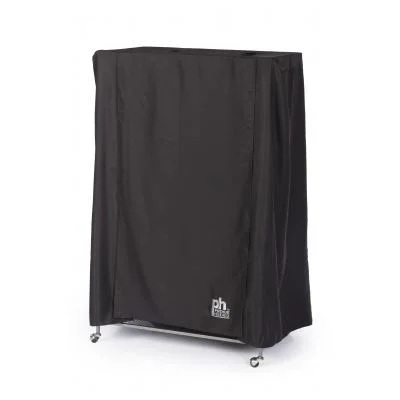

Top Parrot Cages for Happy and Healthy Birds: A Complete Guide
Selecting the right parrot cage is a critical decision that directly affects your bird’s overall well-being. As an owner, your goal is to create an environment that meets the physical, mental, and emotional needs of your feathered companion. Parrot cages are not just places for birds to sleep or eat—they are their primary living spaces. In this guide, we will explore everything you need to know about choosing the perfect bird cage, from the top-rated cages on the market to the essential features and factors you should consider. Whether you’re in search of a big cage for birds, large birdcage, or parrot cage big enough for larger species, we’ve got the information to help you make an informed decision.
Your Parrot’s Needs
To choose the right parrot cage, it is essential to understand the specific needs of your bird. Parrots are intelligent, social, and highly active creatures. They require more than just a place to rest—they need an environment that stimulates them mentally and physically.
- Space for Movement: Parrots need ample space to move their wings, climb, and play. They are highly active birds that benefit from a large area to explore within their cage.
- Mental Stimulation: Parrots are naturally curious and thrive on interactive environments. Without proper stimulation, they may become bored, stressed, and engage in destructive behaviors. Including a variety of bird toys and bird perches can help keep their minds active.
- Comfortable Rest and Sleep: Providing a quiet, safe corner in the cage where the bird can retreat for sleep is vital. It helps promote proper rest and reduces stress.
Factors to Consider When Choosing a Parrot Cage
Size and Space
When it comes to bird cages, size is one of the most critical factors. A parrot needs enough space to move freely, climb, and spread its wings. A big cage for birds isn’t just for larger species—it’s beneficial for all parrots.
- Here is the information in table format:
| Parrot Species | Minimum Cage Dimensions | Additional Space for Enrichment |
| African Grey Parrot | 36 inches (width) x 24 inches (depth) | Ensure space for toys, perches, and swings to promote mental stimulation. |
| Macaw | Larger cages required for comfort | Ample room for enrichment items like swings, climbing areas, and toys. |
Bar Spacing and Thickness
The bar spacing and bar thickness of a parrot cage are important for both safety and comfort. The wrong bar spacing can lead to injury, escape, or stress for your bird.
- Bar Spacing: The spacing should be small enough to prevent your parrot from squeezing through the bars. Smaller species, like Budgies, need closer bars, while larger species, like Cockatoos, need wider spacing (around 1 to 1.5 inches).
- Bar Thickness: The thickness of the bars determines the durability of the cage. For larger parrots, it’s advisable to go for stainless steel bird cages that feature thicker, stronger bars that can withstand their strength and be more durable in the long run.
Material and Durability
The material of your bird cage directly impacts its lifespan, safety, and ease of maintenance. Here’s a breakdown of the most popular materials:
- Stainless Steel: Stainless steel bird cages are often the top choice due to their durability and resistance to rust. These cages are also easy to clean, which is crucial for maintaining your bird’s health.
- Powder-Coated Cages: Powder-coated bird cages are common for smaller birds. These cages are coated with a non-toxic paint that is safe for birds. However, they are generally less durable than stainless steel.
Ease of Cleaning
A clean parrot cage is essential for your bird’s health. The easier it is to clean, the more likely you’ll stay on top of it.
- Removable Trays: Many bird cages come with removable trays at the bottom to make cleaning easier. You can simply pull out the tray, dump any waste, and wipe down the interior.
- Seed Guards: Seed guards help prevent your bird from tossing food and seeds out of the cage, keeping the surrounding area tidy and reducing the amount of cleaning needed.
- Grates: Bird cage grates placed over the tray allow droppings to fall through, preventing the bird from stepping in its waste.
Accessibility and Security
Birds can be delicate, so the bird cage design should ensure easy access for you while keeping your parrot safe inside.
- Doors: The number of doors and their placement are key factors. For example, a large parrot cage may have multiple access points for feeding and cleaning.
- Locks: A strong bird cage lock ensures that your bird remains safely inside its cage. Some cages offer bird cage locks that prevent accidental openings, which is important if you have a particularly clever parrot.
Top Parrot Cages in the Market
King’s Cages Large Bird Cages
- Features: These cages are constructed from heavy-duty materials with non-toxic finishes. Their spacious interiors are perfect for larger parrots, offering both room for movement and the ability to include enrichment accessories.
- Benefits: Known for their bird cage durability and high-quality materials, King’s Cages provides a safe and comfortable environment for birds. Many bird owners appreciate the strength and longevity of these cages.
Bonka Bird Toys Large Bird Cages
- Features: These playtop bird cages are designed for mental stimulation. They come in a variety of sizes to cater to different species of birds.
- Benefits: Apart from the large space, these cages provide extra features like bird cage accessories that help keep your bird engaged and active. The design encourages play and exploration.
Bird Cages 4 Less Parrot Cages
- Features: Offering a wide range of bird cage styles, these cages cater to various species, including dometop bird cages and flight cages. They are customizable with accessories like bird cage stands and bird cage covers.
- Benefits: Affordably priced, these cages are a favorite for budget-conscious bird owners. Their bird cage options cater to a wide range of budgets without sacrificing quality.
PRV Cage 1818
$69.95King Cages SLT 102 Small Parrot Open Square

18100 CAGE LINERS
$14.95
EXTRA LARGE BIRD CAGE COVER
$62.95-
Bird Cages
King Cages SLT 102 Small Parrot Open Square
$499.00Original price was: $499.00.$209.00Current price is: $209.00. Add to cart -
Bird Cages
18100 CAGE LINERS
$14.95Out of stock. Join the waitlist to be notified when this product becomes available. -
Bird Cages
EXTRA LARGE BIRD CAGE COVER
$62.95Out of stock. Join the waitlist to be notified when this product becomes available. -
Bird Cages
LARGE BIRD CAGE COVER
$52.95Out of stock. Join the waitlist to be notified when this product becomes available. -
Bird Cages
GOOD NIGHT BIRD CAGE COVER
$48.95Out of stock. Join the waitlist to be notified when this product becomes available.
Setting Up Your Parrot’s Cage
Perches and Swings
Perches are essential in a parrot’s cage for foot health and comfort. Varying the sizes and materials of perches promotes better foot circulation and encourages the bird to move.
- Varying Sizes: Use a combination of natural wood and synthetic perches to keep your bird engaged.
- Bird Swings: Hanging bird swings gives your parrot a chance to play, swing, and exercise, promoting physical health.
Toys and Enrichment
Parrots are playful and require constant mental stimulation. Adding a variety of bird toys to your parrot cage can prevent boredom and ensure your bird stays healthy.
- Mental Stimulation: Invest in bird toys designed to mimic natural foraging behaviors, such as puzzles or toys that dispense treats.
- Rotating Toys: Rotate your bird’s toys to prevent them from becoming too familiar or stale.
Food and Water Stations
Having accessible and stable food and water stations is essential for your bird’s health.
- Bird Feeders: Use bird feeders that are easy to access and clean.
- Bird Waterers: Bird waterers with a spill-proof design ensure that your parrot’s water stays clean throughout the day.
Maintenance and Cleaning of Parrot Cages
Daily Cleaning Routines
Daily cleaning ensures that your parrot cage remains a healthy environment for your bird. Spot cleaning is essential to remove any waste or food residue.
- Waste Removal: Use a scoop or tray to remove waste and uneaten food.
- Wiping Down: Wipe down surfaces, perches, and bars to keep them free from dust and dirt.
Weekly Deep Cleaning
Every week, a more thorough cleaning is required to ensure the cage remains hygienic.
- Disinfecting: Use bird-safe cleaning products to disinfect the cage.
- Inspect for Damage: Check for wear on bird cage parts like perches or bars.
Safety Considerations
Be mindful of what you use to clean the cage. Harsh chemicals or unsafe products can harm your bird.
- Non-Toxic Products: Always choose bird cage cleaning products that are specifically designed to be safe for birds.
- Avoid Toxic Substances: Be cautious of substances like bleach or ammonia that could damage your bird’s health.
Conclusion
Choosing the right parrot cage for your bird is vital to its happiness and health. Large bird cages with enough space, bird cage accessories for stimulation, and bird cage cleaning for hygiene are all important factors to consider. Remember that a cage is not just a place for your parrot to sleep—it’s an environment where they spend a significant portion of their time. Invest in the best bird cage, and your parrot will thrive in a healthy and comfortable space.
For more detail visit INSTAGRAM
FAQ’s
What size cage does my parrot need?
The cage size depends on your parrot’s species and size. For example, an African Grey parrot may need a cage at least 36 inches wide and 24 inches deep. Larger birds like Macaws require bigger cages to move comfortably.
How can I build a parrot cage at home?
Building a parrot cage requires careful planning to ensure safety and comfort. Materials should be non-toxic, and the design should allow for easy cleaning and adequate space for the bird. It’s essential to consider the bird’s size, species-specific needs, and the cage’s placement in your home.
Which features should a parrot cage possess?
Key features include appropriate bar spacing to prevent escape or injury, non-toxic materials, easy-to-clean surfaces, multiple perches of varying diameters, and space for toys and enrichment items. The cage should also be sturdy and free from sharp edges.
How often should I clean and disinfect my parrot's cage?
It’s recommended to change the cage liner daily and clean the cage thoroughly at least once a week. Using a white vinegar and water solution is an effective and safe way to disinfect the cage.
Can I use a second-hand cage for my parrot?
While using a second-hand cage is possible, it’s crucial to thoroughly inspect it for safety. Ensure there are no toxic residues, sharp edges, or areas that could harm your bird. Cleaning and disinfecting the cage properly is essential before introducing your parrot.
What materials are safe for parrot cages?
Adding a variety of perches, toys, swings, and foraging opportunities can enhance your parrot’s environment. Ensure the cage has multiple levels and spaces for climbing and exploration.
Is it necessary to have a cage cover?
A cage cover can help regulate your parrot’s sleep cycle by blocking out light during the night. It also provides a sense of security and can reduce stress.
How do I prevent my parrot from chewing on the cage bars?
Providing appropriate chew toys and ensuring the cage is made from safe materials can help. Regularly rotating toys and offering natural wood perches can also satisfy your parrot’s chewing instincts.
What is the best placement for my parrot's cage?
It should be in a central location where your parrot can interact with family members but not in high-traffic areas that may cause stress.
How can I ensure my parrot's cage is safe?
Regularly inspect the cage for any signs of wear, sharp edges, or loose parts. Ensure all toys and perches are securely attached and that the cage is free from toxic materials.
Should I provide a nest box in my parrot's cage?
Nest boxes are typically used for breeding purposes. For non-breeding parrots, it’s generally not necessary and can sometimes lead to territorial behavior.
How can I prevent my parrot from becoming bored in its cage?
Regularly changing toys, introducing new foraging opportunities, and providing a variety of perches can help keep your parrot mentally stimulated. Interaction outside the cage is also important for their well-being.
What are the signs that my parrot's cage is too small?
Signs include your parrot not being able to fully extend its wings, frequent pacing, feather plucking, or showing signs of stress. If your parrot spends a significant amount of time in the cage, a larger space is beneficial.
Can I use a cage with horizontal bars for my parrot?
Horizontal bars are beneficial for species that like to climb, such as Amazons and cockatiels. They provide better opportunities for climbing and exercise.






